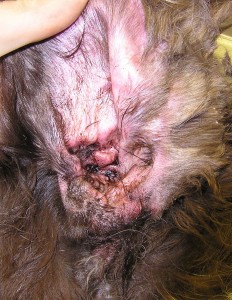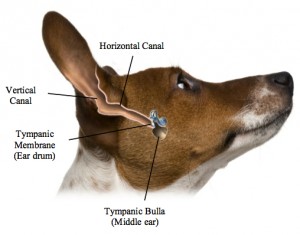
Does your pet scratch his ears? Shake his head? Love to swim? If so, he might have an ear infection.
Most dogs get infections in their ears because of allergies to environmental irritants – and it’s the allergic reaction that makes their ears so irritated. You may also notice an abnormal odor from the ear or see redness & swelling. Once a dog starts scratching because of water in the ear or any other number of irritants, the ear canal lining gets damaged & yeast and bacteria take over.
 Here are some of the contributing causes and perpetuating factors for external ear infections (called otitis externa) and middle ear infections (called otitis media):
Here are some of the contributing causes and perpetuating factors for external ear infections (called otitis externa) and middle ear infections (called otitis media):
- An overgrowth of yeast or bacteria, or often, both
- Wax buildup in the ear canal
- Thick hair in the ear canal
- Hypothyroidism
- Autoimmune diseases
- Tumors within the ear canal
- Ruptured eardrum
- Improper ear cleaning
- Foreign bodies such as bristle from grass
- Environmental irritants
- Diabetes mellitus
Signs That Your Pet Might Have an Ear Infection & Need Veterinary Care
As long pet owners, it’s essential to be vigilant and recognize the signs of an ear infection in our pets. Early detection and prompt treatment can help relieve pain and prevent further complications. Here are some common signs to watch out for:
- Signs of Discomfort: If you notice that your dog or cat has been scratching their ears or shaking their head more frequently than usual, it could be a sign that they are trying to relieve discomfort caused by an ear infection. They also might pull away, yelp, or show signs of aggression when you try to touch their ears. If you notice these signs, it’s best to take your pet to get this problem examined as soon as possible.
- Redness and Swelling: Periodically check your pet’s ears. If you notice redness, swelling, or inflammation in the ear canal or the surrounding area, it could mean that the area is infected. In some cases, the ear itself may look swollen or feel warm to the touch.
- Unpleasant Odor: Bacteria or yeast in the ear can cause a distinct and unpleasant smell. If you notice a foul odor coming from your pet’s ears, bring them to the veterinarian immediately to get their ears checked.
- Discharge or Wax Buildup: Excessive discharge or wax buildup in your pet’s ears can be a sign of an infection. The discharge may vary in color, ranging from yellowish to brown or even black. It may appear thick, crusty, or have a pus-like consistency. If you notice this problem, bring your dog or cat to our animal doctor for further examination.
- Changes in Behavior: Ear infections, like other illnesses, can cause pets to exhibit changes in behavior. They may become irritable, lethargic, or show a decrease in appetite. If you notice any unusual behavioral changes in your pet, it’s worth a vet visit – keep the possibility of an ear infection in mind.
- Balance Issues or Head Tilt: In severe cases or if an infection is left untreated, your pet’s balance and coordination can be affected. You may observe your dog or cat tilting their head to one side; they might also have difficulty maintaining their balance as they once did. These symptoms require immediate veterinary attention.
If you suspect that your pet may have an ear infection, it’s crucial to seek veterinary care. We will take a closer look to diagnose the issue and prescribe treatment to alleviate your furry friend’s pain and return them to better health in no time. Remember, early detection and treatment are key to preserving your pet’s comfort and well-being!
Detecting & Preventing Pet Ear Infections
Infections of the middle ear are usually the result of an infection that has spread there from the outer ear canal.
Prevention depends on identifying the underlying cause of the ear infection. In some cases the ear canal becomes moist from bathing, grooming or swimming. This moisture fosters the growth of microorganisms in the ear canal. Prevention in these cases can be as simple as cleaning the ear as previously described to remove the moisture and prevent the infection. However, in many cases an underlying cause may not be so easily identified.
 Dogs that suffer from allergies, either environmental, such as pollens (grasses, trees and weeds), dust mites, molds or food (beef, chicken, fish, soy, etc.) are predisposed to ear infections. This is due to the microscopic inflammation that allergies cause in the skin allowing overgrowth of bacterial and yeast organisms that normally inhabit the skin.
Dogs that suffer from allergies, either environmental, such as pollens (grasses, trees and weeds), dust mites, molds or food (beef, chicken, fish, soy, etc.) are predisposed to ear infections. This is due to the microscopic inflammation that allergies cause in the skin allowing overgrowth of bacterial and yeast organisms that normally inhabit the skin.
Cats don’t often get ear infections, but when they do, the cause can be complex. If your vet has ruled out ear mites — the culprit in about half of all feline ear infections — they’ll have to do some sleuthing to figure out what’s causing your cat’s outer or middle ear infection. It could be secondary to allergies, a mass, or possibly something lodged in the ear canal.
Bring Your Pet into our Veterinary Clinic for Diagnosis & Treatment of an Ear Infection
If you have any questions regarding treatment or prevention of ear infections for your fluffy family member, call our veterinary clinic at 972-385-3555 so we can help your fur baby feel their best!
Sincerely,



